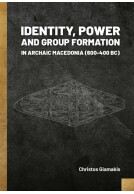Google Books previews are unavailable because you have chosen to turn off third party cookies for enhanced content. Visit our cookies page to review your cookie settings.
Social Groups and Production in Mycenaean Economies (Hardback)
Papers from the Langford Conference, Florida State University, Tallahassee, 24-25 February 2023
Imprint: Sidestone Press
Pages: 172
Illustrations: 31fc / 12bw
ISBN: 9789464263336
Published: 20th March 2025
Script Academic & Professional
Pages: 172
Illustrations: 31fc / 12bw
ISBN: 9789464263336
Published: 20th March 2025
Script Academic & Professional
This book will be reprinted and your order will be released in due course.
You'll be £85.00 closer to your next £10.00 credit when you purchase Social Groups and Production in Mycenaean Economies. What's this?
+£4.99 UK Delivery or free UK delivery if order is over £40
(click here for international delivery rates)
Order within the next 10 hours, 7 minutes to get your order processed the next working day!
Need a currency converter? Check XE.com for live rates
(click here for international delivery rates)
Order within the next 10 hours, 7 minutes to get your order processed the next working day!
Need a currency converter? Check XE.com for live rates
The main goal of this volume is to look at social groups involved in economic activity other than members of the palace-based institutions and “elites” in Late Bronze Age Mycenaean Greek societies. The palaces and elites are the usual subject of studies of ancient economies, often from a top-down approach, but here we consider a fuller range of the members of a society, their organization, their institutions, and their contributions to the economies of those societies from bottom-up approaches.
The traditional model of a highly centralized, redistributive based economy controlled by a palace and its officials is no longer viable. Non-palatial components, institutions, and individuals and how those might be organized are increasingly recognized as major components in economic activity in the Mycenaean world. In this volume we examine the various scales and of actors and institutions in Mycenaean economic activities outside palatial control, including the individual, the household, larger groups such as House societies, and markets. The possibility of Firms in the institutional economic sense is also addressed.
In addition to theoretical and methodological chapters, we present several case studies involving craft production, especially of ceramics. The results of these case studies show how economic organization in the Mycenaean world varies greatly in scale, independence of palatial control, and adaption and resilience to change.
The papers in this volume demonstrate that the economy in Mycenaean states was a complex web of institutions, organizations, and actors, and invites closer comparison to the economy in other ancient and archaic states.
Other titles in Sidestone Press...















